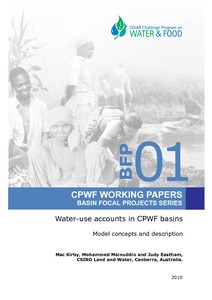Resource information
This paper applies the principles of water-use accounts, developed in the first of the series, to the Nile River basin in Northeast Africa. The Nile and its tributaries flow though nine countries. The White Nile flows though Uganda, Sudan, and Egypt. The Blue Nile starts in Ethiopia. Zaire, Kenya, Tanzanian, Rwanda, and Burundi all have tributaries, which flow into the Nile or into Lake Victoria. Unique features are Lake Victoria and the Sudd wetland where White Nile loses about half of its flow by evaporation, and the Aswan Dam which controls flow in the lower part of the Basin and also is where 15-20% of the flow is lost to seepage and further evaporation.
Net runoff is minimal in many catchments of the Nile Basin, comprising 6% or less of the water available in 16 catchments of the Basin. In the remaining catchments, net runoff ranges from 9% (Panyango) to 34% (Gambella) of the available water.
Water use by grassland is important in all catchments where it comprises 13 to 76% of the water available, except in the Lower Basin, where it comprises only 7% or less of the available water. In upstream catchments, woodlands and forests are the major components of land-use, while in the Lower Basin catchments barren and sparsely vegetated land is the main land-use class.
Rainfed agriculture is the most important water use by volume in only four catchments, Kessie, Paraa, Panyango, and the Sennar Dam where it comprises 24%, 27%, 30%, and 38% of the available water. Nevertheless, it is a relatively important use of water in many of the catchments, using 10% or more of the available water in 14 catchments of the Basin. Irrigated agriculture is the least use of water by volume, using 4% or less of the available water in all catchments except the d/s of Jebel Aulia, the Sennar Dam, Thamaniyat, Hudeiba, Atbara, Naga Hammadi, El Ekhsase, and Estuary catchments. It is, however, the most important water use in the Estuary catchment, using 90% of the available water.
The effect of climate change on rainfall in the Nile Basin is very uncertain, but temperature is expected increase by about 2°C by mid-century. To show the possible effects, we increased potential evapotranspiration by 5%, and left rainfall unchanged. The flow at Aswan Dam declines by about 6%, and irrigated crop water use in the El- Ekhsase region increases by about 2%.


